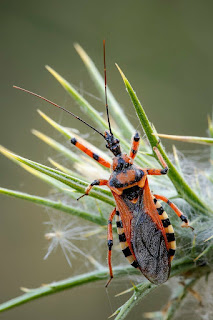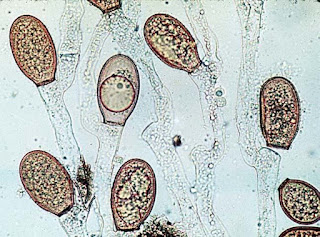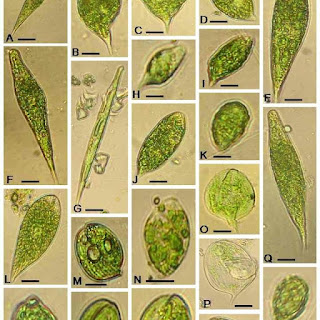Three Domain
Blue Glascus
Scientific classification
Scientific Name - Glascus atlnticus
Domain - Eukaryota
Kingdom - Animlaia
Phylum - Mollusca
Class - Gastropoda
Order - Nudibronchia
Family - Glaucidae
Genus - Glascus
Species - G.atlanticus
Blue Glascus is a species of small, blue sea slug, a pelagic aeolid nudibranch, a shell-less gastropod mollusca in the family Glaucidae. These sea slugs are pelagic; they float upside down by using the surface tension of the water to stay up, where they are carried along the winds and ocean currents.
Since the Blue Glascus stores up the stinging-cells from Portuguese Man O'war, their sting can be several times worse than their siphonophore prey, their venom can remain active even after they die.
Blue Dragons are among nature's most efficient recyclers. But what they are recycling, you don't want. But Blue Dragons are part of nature.
😊😊😊
Bush Crickets
Scientific Classification
Scientific Name - Tettigonia viridissima
Domain - Eukaryota
Kingdom - Animalia
Phylum - Arthropoda
Class - Insecta
Order - Orthrotera
Family - Tettigoniidae
Genus - Tettigonia
Species - T.viridissima
Tettigonia viridissima, the great green bush crickets, is a large species of bush cricket belonging to the subfamily Tetttigoniinae.
This species can be encountered in most of Europe, in the eastern Palearctic realm, in the Near East, and in North America, especially in meadows, grasslands, prairies, and occasionally in gardens at an elevation up to 1800 meter above sea level. Crickets are either green or white. They can live on the ground, in trees, or in bushes, where they feed largely on aphids and ants. The adult males grow up to 26 - 28mm ( 1.1 - 1.4 in ) long, while females reach 32 - 42mm. Crickets generally live for 90 days, depending on the reason and predators.
😊😊😊
Gypsy Moth
Scientific Classification
Scientific Name - Lymantria dispar
Domain - Eukaryota
Kingdom - Animalia
Phylum - Arthropoda
Class - Insecta
Order - Lepidoptera
Family - Erebidae
Genus - Lymantria
Species - L.dispar
Lymantria dispar, also known as the gypsy moth or the spongy moth, is a species of moth in the family Erebidae. Lymantria dispar is subdivided into several subspecies, with subspecies such as L.d.dispar and L.d.japonica being clearly identifiable without ambiguity. The use of " gypsy moth " goes back to at least 1908, and according to various theories, possibly alludes to the way the moth's larvae are blown on the wind or the way it's caterpillars migrate each day from a tree's leaves to shady spots on it's trunk.
The gypsy moth found mainly in Ontario, Quebec, and Maritime provinces. As well as the gypsy moth is native to Europe, Asia, and North Africa. Male gypsy moths are brown. They have a small body and are strong fliers. Female gypsy moths are white with black markings on the wings. They are much larger than males, but they do not fly. After mating, the female lays her eggs before she dies. Gypsy moths complete their life cycle in one year.
The larvae, or caterpillars, of gypsy moth are an important defoliator of a wide range of broadleaved trees and shrubs.
😊😊😊
Ulva
Scientific Classification
Scientific Name - Ulva lactuca
Domain - Eukaryota
Kingdom - Animalia
Phylum - Clorophyta
Class - Ulvophyceae
Order - Ulvales
Family - Ulvaceae
Genus - Ulva
Species - U.lactuca
The sea lettuces comprise the genus Ulva, a group of edible green algae that is widely distributed along the coasts of the world's oceans. The type species within the genus Ulva is Ulva lactuca, lactuca being Latin for " lettuce ". The genus also includes the species previously classified under the genus Enteromorpha, the former members of which are known under the common name green nori.
Ulva is essentially a marine alga generally found on rock shores where it occurs attached to stones, rocks, etc. Some species of Ulva are also found in brackish water and polluted estuaries. It usually grows in association with various other algal species such as Cladophora. Ulva lactuca grows naturallly all over the world, in Europe, North and South America, Africa, the Indian ocean and Pacific islands, Southwest Asia, Australia, and New Zealand. The thallus of ulvoid species is flat and blade-like and is composed of two lagers of cells. There is no differentiation into tissues; all the cells of the plant are more or less alike except for the basal cells, which are elongated to form attachment rhizoids.
😊😊😊
Rainbow Scarab
Scientific Name - Phanaeus vindex
Domain - Eukaryota
Kingdom - Animalia
Phylum - Arthropoda
Class - Insecta
Order - Coleoptera
Family - Scarabaeidae
Genus - Phanaeus
Species - P.vindex
Although most dung beetles are dull black, the rainbow scarab is a living jewel of bright metallic green and copper. They are large, stocky, and strong. Males have a backward - pointing horn on the top of the head. Unlike many other dung beetles, this species buries it's dung ball beneath the mass of poop, instead of rolling it away from the pile. It has distinctive orange antennae with leaflike plates that can be pressed together or fanned apart, and a single spur just above the " foot " of the hind legs. Despite their striking appearance, rainbow scarab are rarely seen, even though they are fairly common.
Rainbow scarab are generally not harmful to humans, although they can fly around and be a nuisance. However, they can cause damage to plants and gardens.
😊😊😊
Leafhoppers
Scientific Classification
Scientific Name - Cicadellidae
Domain - Eukaryota
Kingdom - Animalia
Phylum - Arthropoda
Class - Insecta
Order - Hemiptera
Family - Cicadellidae
Sharpshooters are leafhoppers in the tribes Proconiini and Cicadellini within the family Cicadellidae in the suborder Auchenorrhyncha of the Hemiptera. Worldwide, there are nearly 20,000 described species, making the Cicadellidae the 10th largest insect family. These minute insects, colloquially known as hoppers, are plant feeders that suck plant sap from grass, shrubs, or trees.
Although leafhoppers damage grasses and other plants, also they are part of nature.
😊😊😊
Mantis
Scientific Classification
Scientific Name - Mantis religiosa
Domain - Eukaryota
Kingdom - Animalia
Phylum - Arthropoda
Class - Insecta
Order - Mantodea
Family - Mantidae
Genus - Mantis
Species - M.religiosa
Mantises are an order of insects that contains over 2400 species in about 460 genera in 33 families. The largest family is the Mantidae. Mantises are distributed worldwide in temperate and tropical habitats. They have triangular heads with bulging eyes supported on flexible necks. The earliest mantis fossils are about 140 million years old, from Siberia. Praying mantids have long necks topped by a triangular head. They can turn their heads 180 degrees an entire half circle. They are well camouflaged, adapting colors that help them blend with plants. Some also have amazing body shapes that make them look like leaves or branches.
The praying mantis is found in many differing habitats. They are generally located in the warmer regions, particularly tropical and subtropical latitudes. Most species live in the tropical rainforest, although others can be found in deserts, grasslands and meadowlands. Mantises are among the largest insects. Adults generally range from 2 to 5 inches ( 5 - 12 cm ) long. Adults and nymphs are elongate and usually brown, green, or yellowish; a single species can have all 3 colors phases, such as the California mantid, Stagmomantis wheeleri.
Despite their small size, they may not eat spiders, frogs, lizards, and small birds, praying mantises aren't generally known to bite humans, but it is possible. They could do it by accident if they see your fingers as prey, but like most animals, they know how to correctly identify their food. Praying mantises have no venom and cannot sting. Nor do they carry any infectious diseases.
😊😊😊
Hercules Beetle
Scientific Classification
Scientific Name - Dynastes hercules
Domain - Eukaryota
kingdom - Animalia
Phylum - Arthropoda
Class - Insecta
Order - Coleoptera
Family - Scarabaeidae
Genus - Dynastes
Species - D.hercules
The Hercules Beetle is a species of rhinoceros beetle native to the rainforests of Central America, South America and Lesser Antilles. It is the longest extant species of beetle in the world, and is also one of the largest flying insects in the world. Dynastes hercules is known for it's tremendous strength and is named after Hercules, a hero of classical mythology who is famed for his great strength.
Populations of Dynastes hercules may be found from Southern Mexico to Bolivia in mountainous and lowland rain forests, Known populations include the Lesser Antilles, Trinidad and Tobago, Brazil, Ecuador, Colombia, and Peru. Chromosomal analysis has shown that the genus Dynastes in fact originated from South America. Adult body sizes vary between 50 and 85mm in length and 29 and 42mm in width. Male Hercules beetles may reach up to 173mm in length, making them the longest species of beetle in the world, if jaws and/or horns are included in the measurement. Beetles have four stages of development, egg-larvae-pupa-adult, and can live up to 6 months depending on availability of food.
Because of their large size and impressive horns, many people believe that Hercules beetles are dangerous. But it does not negatively affect human activities, either as an agricultural pest or disease vector. In fact, their horns are not dangerous at all, and the beetles are not known to bite. However, if you pick one up, it may scratch you with it's strong, spiny legs.
😊😊😊
Assassin Bugs
Scientific Classification
Domain - Eukaryota
Kingdom - Animalia
Phylum - Arthropoda
Class - Insecta
Order - Hemiptera
Family - Reduviidae
Hemiptera is an order of insects, commonly called true bugs, comprising over 80,000 species within groups such as the cicadas, aphids, planthoppers, leafhoppers, assassin bugs, bed bugs, and shield bugs. They range in size from 1mm to around 15cm, and share a common arrangement of piercing-sucking mouth parts. Assassin bugs are predatory insects that are of great benefit to gardeners. They are proficient at capturing and feeding on a wide variety of prey including other bugs, bees, flies and caterpillars. They are called assassins because they pierce their prey think other bugs, caterpillars and flies with their long mouthpieces. These bugs not only bite, but their " kiss " can spread a parasite that causes chagas disease, which can cause damage to major organs, lead to heart failure, and even be fatal. However, the transmission of the trypanosoma cruzi parasite from a bug to a human is not easy. The parasite that causes the disease is in the bug feces. The bug generally poops on or near a person while it is feeding on their blood, usually when the person is sleeping.
😊😊😊
Treehoppers
Scientific Classification
Scientific Name - Ceresa taurina
Domain - Eukaryota
Kingdom - Animalia
Phylum - Arthropoda
Class - Insecta
Order - Hemiptera
Family - Membracidae
Genus - Ceresa
Species - C.taurina
There are approximately 3200 described species of treehoppers worldwide, 257 of which live in North America. Currently, these insects are placed in three separate families : Melizoderidae, Aetalionidae and Membracidae. Membracidae is by far the largest and most widespread. Ceresa taurina is a half-winged insect of the family Membracidae. The body color is bright green, the thorny projection of the pronotum or pronotum points posteriorly and has two pointed projections on the front pointing forward. with some imagination this is reminiscent of the horns of a bull and it is from this that the scientific generic name taurina is due, which is derived from the Latin taurus, " bull ". The cicada has a strongly arched body shape with large wings and to other animals it looks strikingly like a young leaf with spines. Individuals treehoppers usually live for only a few months, but they belong to a lineage that is at least 40 millions years old. The oldest undoubted treehopper fossils are specimens of a few as yet undescribed species from amber found in the Dominican republic. Ceresa taurina feeds on various plants, sucking the juices up through the sucking proboscis or rostrum. The cicades live on plants used by humans as a source of food , such as raspberry, apple and pear, among other things.
😊😊😊
Diabolical Ironclad
Mucor
Scientific Classification
Scientific Name - Mucor
Domain - Eukaryota
Kingdom - Fungi
Phylum - Zygomycota
Class - Zygomycetes
Order - Mucorales
Family - Mucoraceae
Mucor is a microbial genus of approximately 40 species of moulds in the family Mucoraceae. Mucor mucedo, commonly known as the common pinmould, is a fungal plant pathogen and member of the phylum Mucoromycota and the genus Mucor. Mucor indicus, one of the most important stains of Zygomycetes fungi, has been the subject of several studies since a couple of hundred years ago.
Species are commonly found in soil, digestive systems, plant surfaces, some cheeses like Tomme de Savoie, rotten vegetable matter and iron oxide residue in the biosorption process. The Mucorales are characterized by anamorph structures. The mycelium is typically non-septate or irregularly septate. Sporangiospores are produced in multi-sporangia. The sporangia are characterized by the inclusion of a variously shaped columella.
Fungi order of the Mucorales colonize all kinds of wet, organic materials and represent a permanent part of the human environment. They are economically important as fermenting agents of soybean products, and producers of enzymes, but also as plant parasites and spoilage organisms.
😊😊😊
Paramecium
Scientific Classification
Scientific Name - Paramecium
Domain - Eukaryota
Kingdom - Protista
Phylum - Ciliphora
Class - Oligohymenophorea
Order - Peniculida
Family - Parameciidae
Genus - Paramecium
Paramecium or Paramoecium is a genus of unicellar citiated protozoa. They are characterised by the presence of thousands of cilia covering their body. Paramecium were among the first cillates to be seen by microscopists, in the late 17th century. They were probably known to the dutch pioneer of protozoology, Antoine Van Leeuwenhoek, and were clearly described by his contemporary.
Paramecium live in aquatic environments, usually in stagnant, warm water. The species Paramecium bursaria forms symbiotic relationships with green algae. The algae live in it's cytoplasma. Algal photosynthesis provides food source for Paramecium. Some species form relationships with bacteria. Species of Paramecium range in size from 50 to 330 micrometers in length. Cells are typically ovoid, elongate, foot - or cigar - shaped.
Paramecium can have both positive and negative effects on humans. Paramecium have potential to spread harmful diseases in the human body by imbalance, but they can also serve a benefit to humans by destroying cryptococcus neoformans, a type of disease caused by special fungi ( from the genus cryptococcus ) that can spread in the human body and and affect the immune system.
😊😊😊
Chytridium
Scientific Classification
Scientific Name - Chytridium
Domain - Eukaryota
Kingdom - Fungi
Phylum - Chytridiomycota
Class - Chytridiomycetes
Order - Chttridiales
Family - Chytridiaceae
Genus - Chytridium
Chytridium is a genus of fungi in the family Chytridiaceae. With the culture and characterization of Chytridium olla, the type species of the order, the limits of the chytridiales were established. Chytridiomycota, a phylum of fungi distinguished by having zoospores with a single, posterior, whiplash structure. Species are microscopic in size, and most are found in fresh water or wet soil. Most are parasites of algae and animals or live on organic debris. This order includes 65 genus and 300 species. They are the most primitive and simplest members of true fungi. They are often called the chytrids. The chytrids include both aquatic and soil inhabiting species. A few species are marine.
😊😊😊
Euglena
Scientific Name - Euglena sp
Domain - Eukaryota
Kingdom - Protista
Phylum - Euglenozoa
Class - Euglenoidea
Order - Euglenales
Family - Euglenaceae
Genus - Euglena
Euglena is a genus of single cell flagellate Eukaryotes. It is the best known and most widely studied member of the class Euglenoidea, a diverse group containing some 54 genus and at least 200 species. Euglena live in fresh and brackish water habitats such as ponds rich in organic matter. Some species can form green or red " blooms " in ponds or lakes. The single cells are biflagellate, with the flagella originating in a small reservoir at the anterior of the cell. The Euglena is unique in that it is both heterotrophic ( must consume food ) and autotrophic ( can make it's own food ). Chloroplasts within the Euglena trap sunlight that is used for photosynthesis, and can be seen as several rod like structures throughout the cell. Euglena is recommended for regulating bowel movements, improving energy levels, and supplementing those who have no time to prepare nutritious meals. As a component in cosmetics and beauty products, Euglena helps to make skin smoother, more elastic and radiant. Euglena species are parasites that may be a cause of serious blood and tissue diseases in humans. Euglena produces a neurotoxin named euglenophycin which can be deadly for fresh water fishes. It forms toxic algae blooms in fresh water which harm water habits.
😊😊😊
Elysia chlorotica
.jpeg)











.jpeg)













.jpeg)
.jpeg)
.jpeg)










.jpeg)


Comments
Post a Comment
Do leave your comments